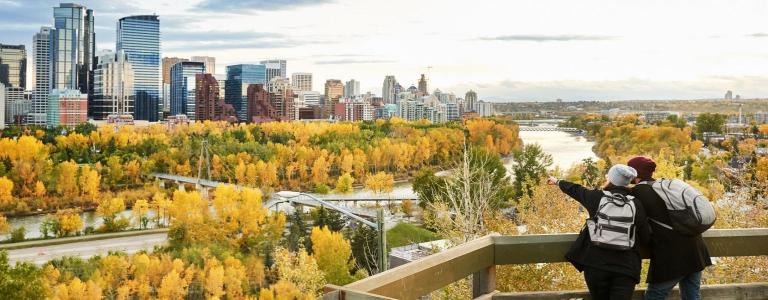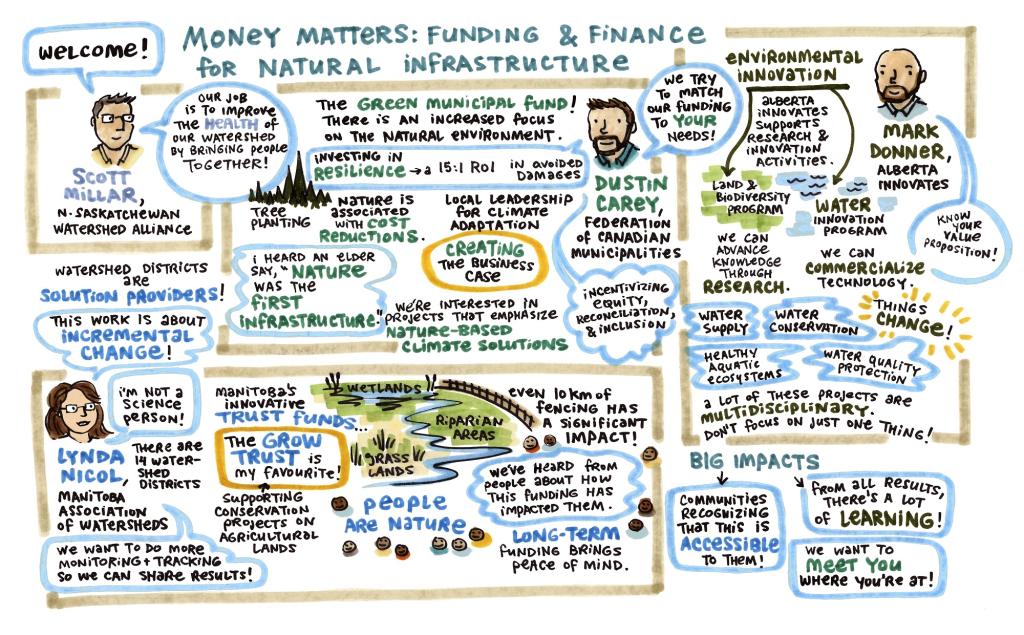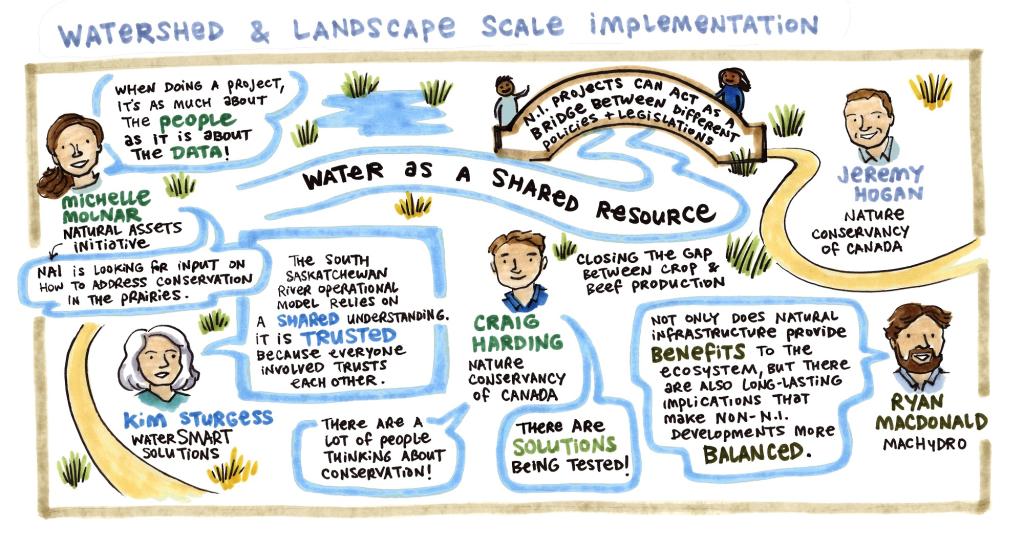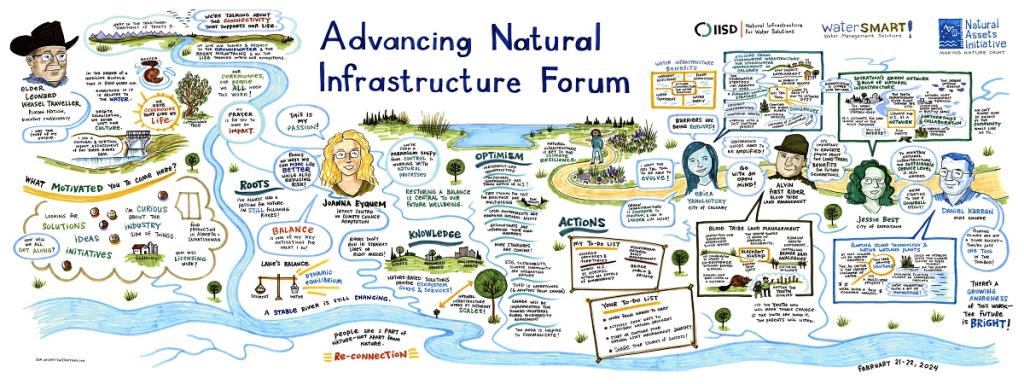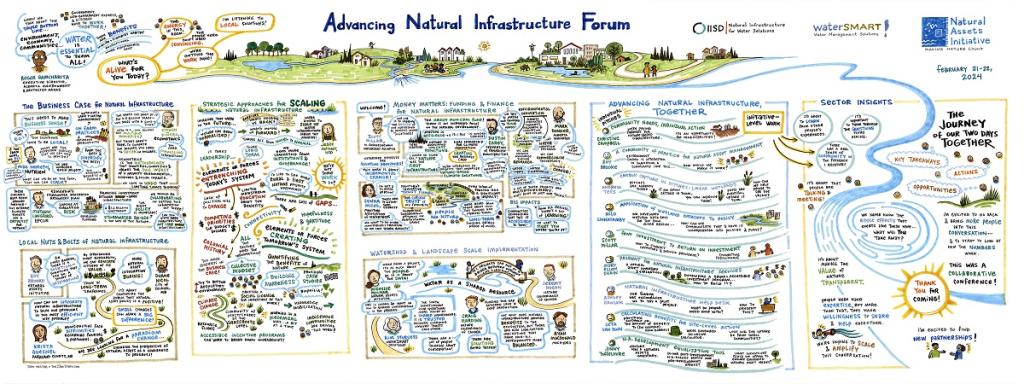Advancing Natural Infrastructure 2024 Forum - Recap and Resources
In February, the International Institute for Sustainable Development (IISD) co-hosted the Advancing Natural Infrastructure on the Canadian Prairies Forum in Calgary, Alberta, with the Natural Assets Initiative and WaterSMART Solutions. As part of IISD’s Natural Infrastructure for Water Solutions initiative, the 2-day event drew close to 100 participants from across the prairie provinces—implementers, innovators, and individuals who work in fields related to natural infrastructure.
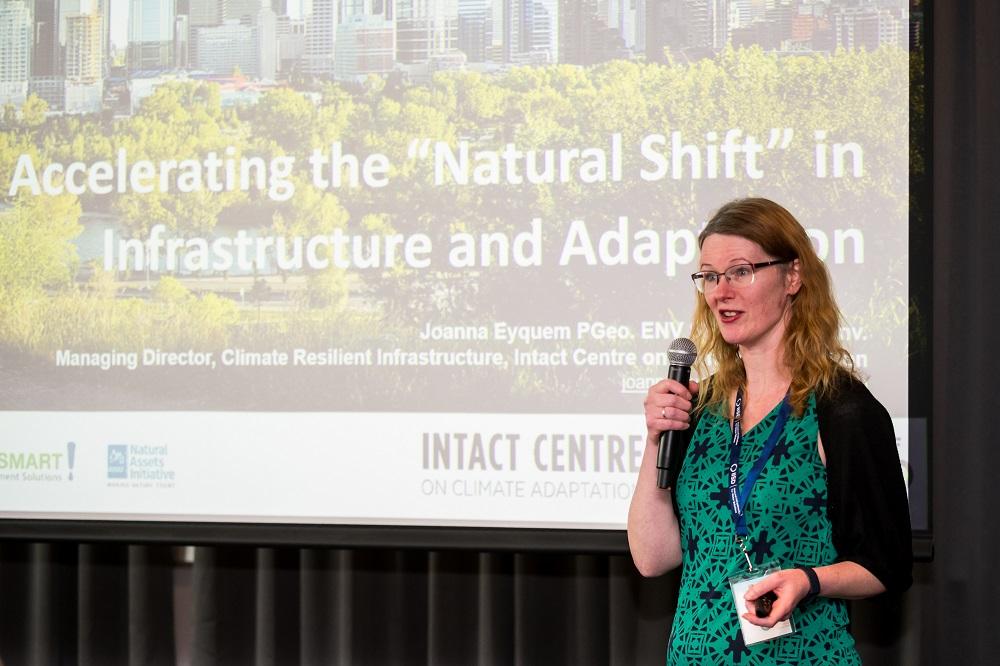
Prominent Themes From the Forum
- Projects across the prairies are supporting water infrastructure needs for water treatment, supply, and flood and drought protection. There is growing momentum around natural infrastructure, and communities are seeing multiple benefits across the triple bottom line. This trend is evident not only in major cities like Calgary and Saskatoon but also in rural and smaller communities like Parkland County, Alberta, and the Town of Selkirk, Manitoba, among many others.
- The network of practitioners and leaders advancing natural infrastructure— in urban, rural, and Indigenous communities—is growing across the prairies. The forum outlined several reasons for optimism, including federal recognition and support, Indigenous-led efforts, more standardization of designs and methods, and an increasing number of case studies that showcase resilience benefits, among others.
- When considering infrastructure options, work “from green to grey.” Consider first the ways natural (or green) infrastructure can meet or support service delivery, then introduce grey infrastructure options as needed. While grey infrastructure is the norm, many small shifts toward natural infrastructure will have a noticeable impact. We must showcase more social, environmental, and economic benefits to incentivize decision-makers toward working with nature.
- Collaborative and cross-jurisdictional efforts are needed, mainly to realize benefits at watershed scales. Provincial, local, and Indigenous governments have a crucial role in prioritizing natural infrastructure backed by dedicated funding and enabling policy. Positioning natural infrastructure as a way to address multiple intersecting societal challenges—e.g., infrastructure, climate adaptation, biodiversity, and reconciliation—is essential for future work. Indigenous People are leading the way through, for example, Indigenous Guardians programs or the installation of beaver dam analogs analogues in the face of drought.
- There is a growing tool kit of resources to support natural infrastructure efforts, including a new national standard for natural asset inventories and technical guidance for nature-based solutions. Multiple organizations and jurisdictions offer approaches and tools to identify, quantify, and value the many benefits of natural infrastructure projects, including the Natural Assets Initiative, IISD, Ecometrics, and others. Embedding nature and natural assets in asset management, accounting, and corporate reporting, through for example, the Task Force on Nature-Related Financial Disclosures, is also an essential avenue for scaling.
“We’re talking about infrastructure, but we’re also talking about nature, animals, and people.”
Seven Lessons From the Advancing Natural Infrastructure Forum 2024
Momentum Is Building, but There Is Much More To Do
During the keynote address, Accelerating the Natural Shift in Infrastructure and Adaptation, Joanna Eyquem of the Intact Centre on Climate Change Adaptation reminds us to find the balance in our work: “Restoring balance within our natural systems, working with rather than controlling natural processes, is central to our future well-being.” Joanna outlined ten reasons for optimism, including more Indigenous-led opportunities, the federal government taking notice of natural infrastructure, local governments managing natural assets, and an increase in case studies for nature-based solutions. She concluded by sharing a “to-do” list with participants, encouraging embedding natural infrastructure within decision making and greater adoption within all levels of government, actively seeking to restore natural processes, and sharing the stories of success.
Funding Programs Are Enabling Natural Infrastructure Projects
Funding for natural infrastructure on the Canadian Prairies is more important than ever. Moderated by Scott Millar of the North Saskatchewan Watershed Alliance, the Money Matters: Funding and Finance for Natural Infrastructure panel showcased leading funding programs.
During the panel, Dustin Carey with the Federation of Canadian Municipalities announced a new CAD 530 million community-based climate adaptation initiative. The Green Municipal Fund is launching the Local Leadership for Climate Adaptation initiative, which will fund more than 1,400 municipal activities that build resilience to climate change by 2031. According to Dustin, projects that emphasize nature-based climate solutions will benefit from a higher cost share percentage from the Green Municipal Fund, which is a clear acknowledgement of the multiple benefits of natural infrastructure. Lynda Nicol of the Manitoba Association of Watersheds also highlighted Manitoba’s GROW Trusts as a funding model driving tangible outcomes for local communities and watersheds in Manitoba, supported by a CAD 204 million investment in three endowment funds.
Here are some highlights from the panel, courtesy of graphic recorder Sam Hester. (click to enlarge)
Think and Collaborate at Larger Scales
Joanna Eyquem also flagged the opportunity for natural infrastructure to help solve issues at watershed scales with multiple groups working together across jurisdictions. While collaborative projects take time, they are essential. Joanna referenced the Port Lands Flood Protection Project in Toronto, Ontario. Decades in the making, this massive project will reroute the river in part to be more meandering and will not only provide flood protection—it will also add greenspace, wildlife habitat, and housing.
On Day 2 of the forum, a session on watershed- and landscape-scale implementation profiled different ways that groups are working toward watershed-scale efforts through, for example, natural asset management, water infrastructure modelling, and prairie-wide conservation of priority landscapes.
Here are some highlights from the Watershed- and Landscape-Scale Implementation session, courtesy of our graphic recorder Sam Hester. (click to enlarge)
Beavers Aren’t Bad Guys
Alvin First Rider, an environmental technician from Blood Tribe Land Management, described how beavers have been considered a nuisance throughout colonization. However, constructing beaver dam analogues (small dams built with natural materials) can help slow water flow across the landscape, recharging aquifers and alleviating drought. One project that was instrumental in understanding beaver presence and informed restoration locations was Beavers From Space, which aimed to increase the coexistence of humans and beavers while also educating people on how beaver dams can help with flood/drought mitigation, enhancing water quality and reducing fire risk.
“It’s important to educate people about the long-term benefits for future generations,” said First Rider. “It’s the youth who will make things change. If the youth are doing it, the parents will listen.”
He mentioned the importance of amplifying Indigenous voices in this work and reminded participants to get back to partnering. “Don’t be afraid to reach out to your neighbours,” said First Rider. “Don’t always be so technical and look at things from a different lens.”
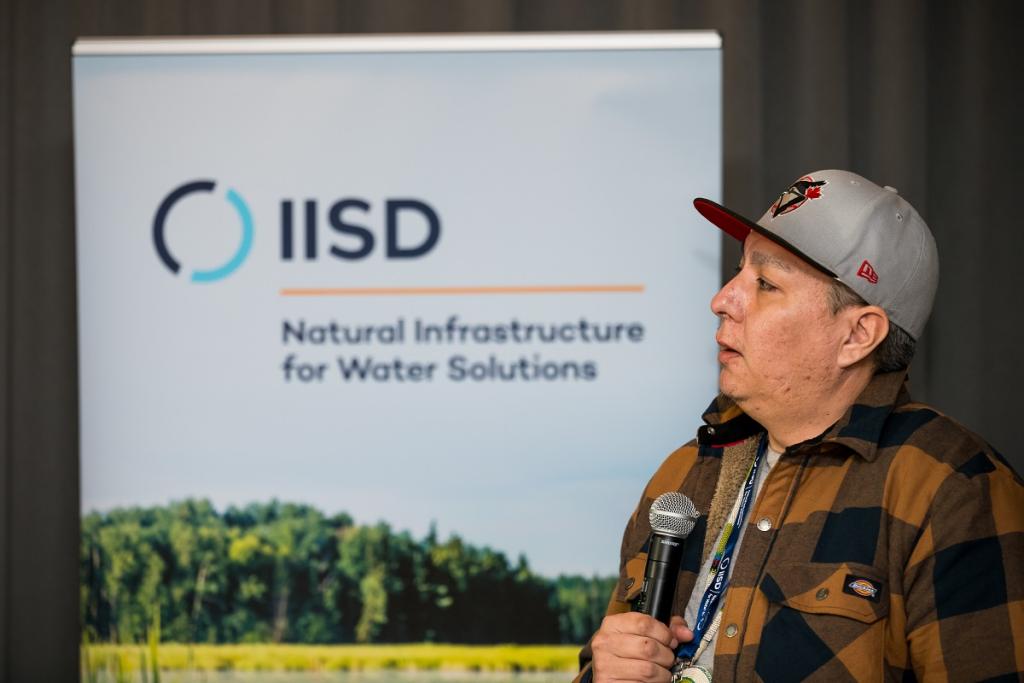
Mainstream Natural Assets Management
Protecting and managing natural assets—and knowing what you have—was a key theme of the forum. During the session on Bright Spots, Jessie Best, a project manager with the City of Saskatoon, emphasized the importance of starting with a natural assets inventory. In Saskatoon, the inventory showed that natural assets comprise 7% of the city's footprint. This information allowed the city to better assess the distribution of natural infrastructure in line with its Green Network Project and to leverage over CAD 34 million in funding from sources such as Infrastructure Canada’s Natural Infrastructure Fund to support a range of natural infrastructure projects.
Multiple prairie communities have taken stock of their natural assets, including the Town of Okotoks, the City of Calgary, the Winnipeg Metropolitan Region, and Parkland County. Groups like the Natural Assets Initiative and the Miistakis Institute are also available to support communities in their natural asset management journeys.
Rural Municipalities Have Shown Leadership in Natural Infrastructure
Alberta’s Parkland County won an award in 2022 from the Federation of Canadian Municipalities for their work with natural infrastructure. Upstream from Edmonton, activities within the county influence the source of drinking water for over 1.6 million people. Like many municipalities, Parkland County faces extreme weather events, including wildfires, droughts, and flooding, as well as the degradation of natural assets. Krista Quesnel, the Director of Agricultural and Environmental Services for Parkland County, explained that by understanding natural assets in the county, they were able to reduce the risk of flooding and road washouts, saving on maintenance costs. Examples of natural infrastructure include the construction of a wetland along a road to prevent washouts and riparian restoration to reduce the velocity of flood water. They also identified other potential areas for restoration—the resulting benefits of their work include improved ecosystem health, better water quality, and carbon sequestration.
Selkirk, Manitoba, is also leading the way in natural infrastructure work in Canada. Duane Nicol, the city's Chief Administrative Officer, explained that Selkirk was the first municipality in Canada to have an asset management bylaw with a section dedicated to natural assets. Today, 75% of the actions to increase the city's resiliency, as outlined in its Climate Change Adaptation Strategy, are related to natural assets.
When it comes to developing natural asset management plans, Duane suggests that incremental and consistent change is better than grand and periodic changed, habit and routine are more powerful than inspiration and motivation, and to think in systems and long-term timeframes. It is also essential to communicate the co-benefits of natural infrastructure, selling the benefits beyond the obvious. Duane adds that focusing on the community you serve is important: “If we can convince the public that natural asset policy is a positive, you can get more support for policies.”
Agriculture Can Benefit From Natural Infrastructure
“A lot of agricultural operations result in water runoff that is not suitable for re-use,” points out Daniel Karran, an instructor and research scientist from Olds College in Alberta. A solution? Natural infrastructure.
Floating treatment wetlands can be used to remove excess nutrients from the water, and Daniel points out they’re useful for stormwater and wastewater management, with research underway to understand their effectiveness for contaminated livestock water.
Mike Nemeth, a senior advisor in agricultural and environmental sustainability at Nutrien, shared some examples of how farmers can enhance natural infrastructure and improve sustainability on cropland. Mike highlighted the growing international momentum for major companies to prioritize nature-based solutions in their sustainability portfolios and within financial or environmental, social, and governance disclosures. Wetland restoration, riparian management, and vegetated buffers are a few examples of using natural infrastructure to benefit agriculture. Nemeth mentions that using natural infrastructure and beneficial management practices in farming could help build a business case for more investment in water stewardship and other environmental outcomes.
Photos from the Forum
See more photos taken by our Photographer Suzan McEvoy, Photos with Finesse, at the following gallery.
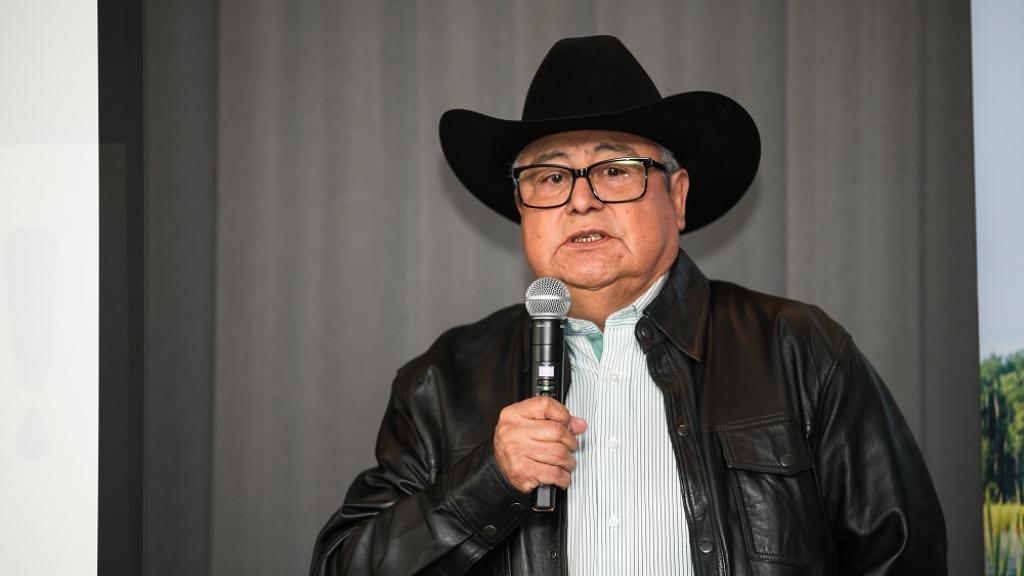
Elder Leonard Weasel Traveller of the Piikani Nation, Blackfoot Confederacy
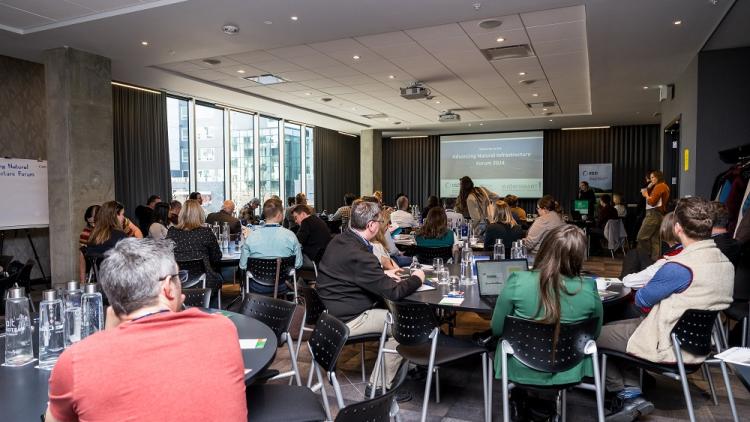
Josée Méthot opening the Advancing Natural Infrastructure Forum
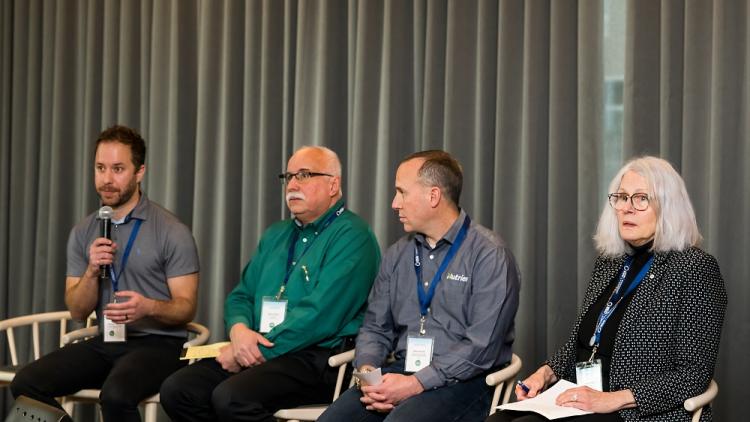
The Business Case for Natural Infrastructure Panellists

Attendees chat during a break at the Advancing Natural Infrastructure Forum
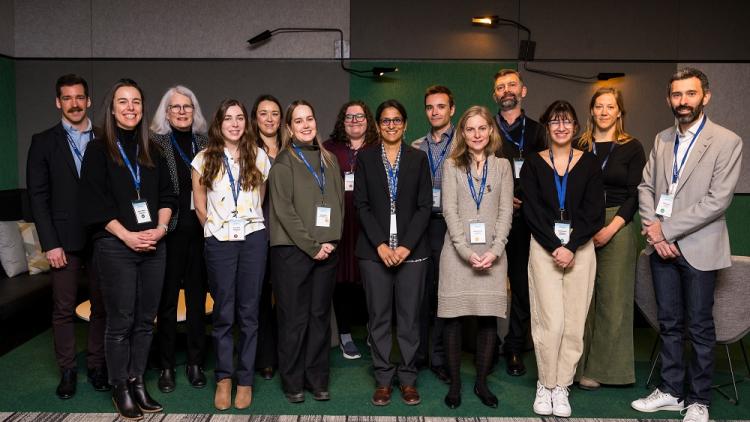
Organizers of the Advancing Natural Infrastructure Forum co-host organizations, IISD's NIWS Initiative, WaterSMART, Natural Assets Initiative, and the Arete Initiative facilitators.
Resources Shared at the Advancing Natural Infrastructure Forum
Resources are organized by session.
